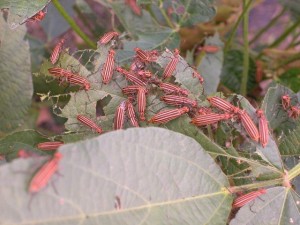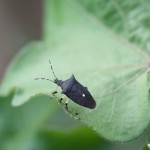I’ve had the first report of a soybean field in Tennessee being treated for kudzu bug. The field is located in East Tennessee (Polk County). Continue reading
Category Archives: Soybean
ALERT – Fall Armyworms in Soybean
When the stars align, fall armyworm larvae can completely defoliate soybean (pictured below). The common scenario … larvae infest grassy weeds in late planted or double cropped fields and then move onto the soybean plants, especially if Round-Up Continue reading
Soybean – Spider Mites and Stink Bugs
Caterpillar infestations, including corn earworm, continue to be light in soybean. However, scouting late planted fields for corn earworm is a must. Concentrate your efforts on fields at R1 or R2. This will include many wheat beans. For the most part, other pest action continues to be light. But exceptions prove the rule. Continue reading
Crop Progress
As reported by NASS on July 16, 2012
DROUGHT NOT OVER BUT WIDESPREAD, PLENTIFUL PRECIPATATION RECEIVED! Soaking rainfall and lower temperatures characterized the conditions which greeted farmers last week. The drought is not broken as some areas of the state experienced only light-to-moderate precipitation. Overall, state crop condition ratings improved, especially for soybeans. However, the corn condition rating, although improved, continued to point to a season with over half the acreage in a heavy or extreme loss of yield situation. Some renewed optimism now exists for soybeans, cotton and tobacco which are rated in mostly fair or good condition. Continue reading
Insect Pressure Sporadic

Soybean – There have been few calls on soybean. Stink bug populations are low with a few exceptions. However, I’ve definitely seen an upturn of green stink bug adults in early maturing soybean. No significant infestations of corn earworm or other caterpillar pests have been reported. With some of the recent rains, insect pressure may pick up. I’ve had a few calls on blister beetles, primarily the striped blister beetle. Seeing a few small spots of blister beetles Continue reading
IPM in a Drought
Still haven’t had a rain? I can’t spin this. If you are not irrigating or had a good rain, drought is seriously hurting yield potential. So what does this mean in terms of insect control? There is talk about abandoning the crop or discontinuing insect management. In some cases, it makes sense to relax treatment thresholds, but we need to maintain Continue reading
Crop Progress
As reported by NASS on July 9, 2012
SCATTERED SHOWERS PROVIDE A LITTLE RELIEF. A slight break from record setting temperatures came at weeks’ end and was due to several rounds of scattered showers and thunderstorms. Soil moisture levels are still extremely short and more rain will be needed for crops and pastures to rebound from the prolonged drought conditions. Crop conditions continued to decline last week. Pastures have been the hardest hit by the high temps and short moisture supplies with three quarters of the acreage rated in very poor-to-poor condition. Continue reading
The Black Stink Bug

Just another “bug if the week” entry featuring the black stink bug (Proxys punctulatus). I get one or two calls each year about this insect which shows up periodically in field crops. The black color, conspicuous white spot on its back, spined shoulders, and black and white legs make the adults easy to identify. I see the black stink bug most commonly on cotton where it will feed on plants and is also reported to occasionally prey on caterpillars. It is uncommon enough in Tennessee to just be a curiosity. I don’t know what the immature stages look like, and pictures are apparently hard to come by.

